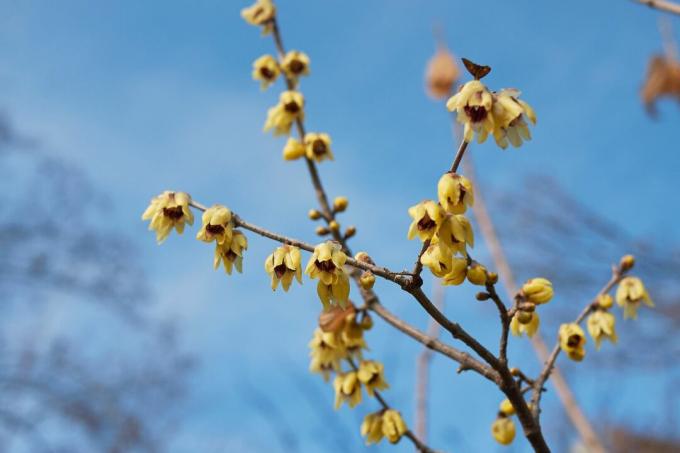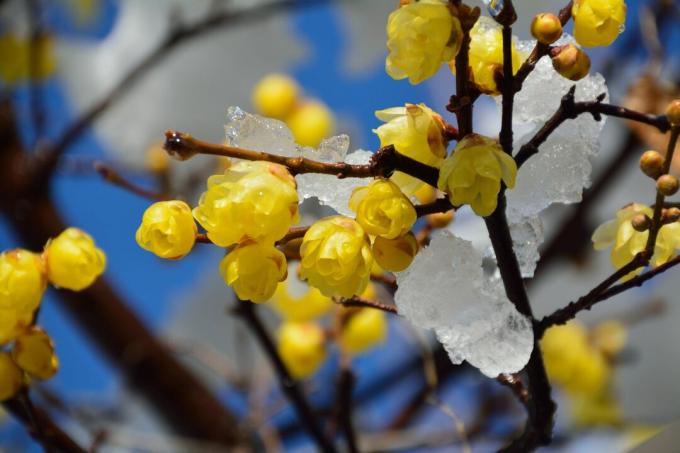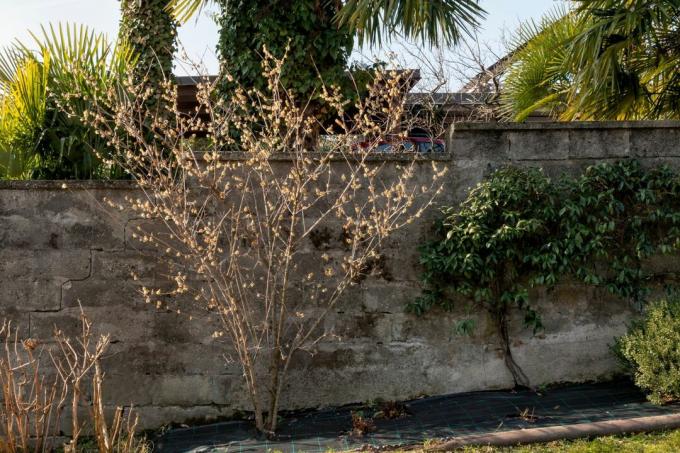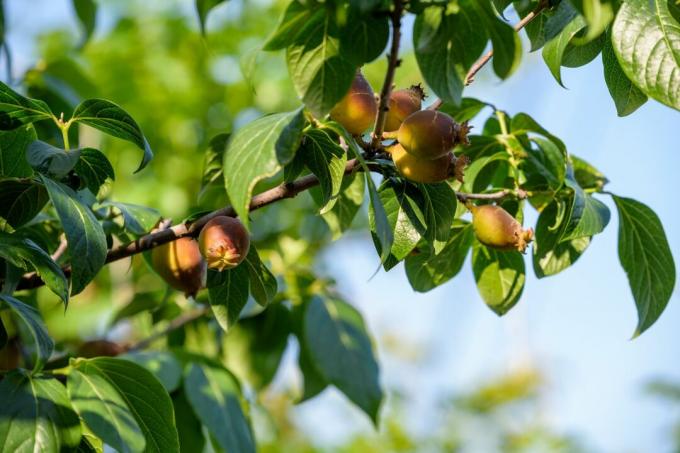If the Chinese winter blossom feels comfortable in its location, it partly blooms in bright yellow as early as December and smells pleasantly lovely of vanilla.

Even if the Chinese winter bloom (Chimonanthus praecox) is still relatively unknown to us, it is definitely worth growing. The easy-care shrub not only delights us in winter with its fragrant flowers, but is also pollinated by insects, which is why Chimonanthus praecox is valuable to bees. In this article we explain everything you need to know about the cultivation, location and care of Chimonanthus praecox need to know. You will also learn whether the Chinese winter blossom is poisonous.
contents
- Chinese winter bloom: origin and characteristics
- The most beautiful varieties
- Plant Chimonanthus praecox
-
Chinese winter bloom: the main care measures
- Pour properly
- Fertilize Chinese winter blossom
- Cut back
- wintering
- Multiplication
- Is the Chinese Winter Blossom Poisonous?
Chinese winter bloom: origin and characteristics
As one can already suspect, the Chinese winter bloom originally comes from China, where it grows at an altitude of up to 3000 m. But it has also been cultivated in Europe for a few hundred years. The Chinese winter bloom is a perennial, almost winter hardy shrub that reaches heights of 250 to 300 cm and can withstand temperatures of up to - 17 ° C. It grows multi-stemmed, bushy and fan-shaped and can therefore take up a lot of space. The foliage is green in summer, turns yellow in autumn and is thrown off shortly before flowering begins.

The great peculiarity of this plant is reflected both in the German name and in the scientific name. This is derived from ancient Greek: "Cheimon" stands for winter and "anthos" for blossom. The species name "praecox" refers to the very early flowering. Even if Chimonanthus praecox When it blooms in winter, the shrub is pollinated by insects, because on warmer days they fly and crawl and are happy about any food. thats why Chimonanthus praecox an important, bee-friendly shrub. The flowers usually appear around December, are about 2.5 cm in size, yellow and have a pleasant, lovely scent. The long flowering period, which can extend into March, is also outstanding. As with many other plants that bloom in winter, this is a protective mechanism, because frosts can cause the flowers to freeze over and over again. After blooming, fruit capsules appear in spring that contain up to 1.5 cm long, coffee bean-shaped seeds. However, these only mature completely in warm years.

Tip: Anyone who grows the Chinese winter blossom from seeds or buys very young plants usually has to wait a little longer before they can admire the blossom for the first time. Because after sowing, it usually takes five to eight years for the shrub to bloom for the first time.
The most beautiful varieties
The entire family of the herbaceous plants (Calycanthaceae) comprises only about ten species. This includes the small number of varieties of the Chinese winter blossom. Nevertheless, we would like to introduce two of them to you, which you can also find in gardening stores in Germany.
- Chimonanthus praecox "Grandiflorus": As the name suggests, this variety is characterized by particularly large flowers. In terms of growth and hardiness is Chimonanthus praecox ‘Grandiflorus’, however, comparable to the wild form Chimonanthus praecox.
- Chimonanthus praecox "Luteus": This variety also only differs from the wild species in terms of the flowers, because they are at Chimonanthus praecox ‘Luteus’ of a particularly intense yellow.

Plant Chimonanthus praecox
A suitable location for Chimonanthus praecox is at best in a sunny, sheltered location. It should be characterized by a deep, permeable and nutrient-rich soil. As for pH, the plants are amazingly tolerant and adaptable, but prefer neutral to calcareous soils. If you have acquired young plants, they can be planted in their final location from spring to autumn, with spring being the optimal planting time. This means that the young bushes still have enough time to take root before the next winter.
The following instructions will help you plant out Chimonanthus praecox problem-free in your own garden:
- Choose a sunny, sheltered location.
- Dig a planting hole at least twice the size of the root ball.
- Now you can also take measures to improve the soil: In the case of very clayey soils that tend to waterlogging, 30% expanded clay or sand like ours should be loosened Plantura lawn sand be mixed in. Since the winter bloom is a heavy drain, some compost or a pre-fertilized soil like ours improves Plantura organic universal soil in addition, the growth of the young plant.
- Now the winter bloom can be planted in the ground. The surface of the ball of the earth should be at the level of the subsoil.
- The planting hole is filled with a mixture of soil, potting soil and possibly sand until the ball of the earth is lightly covered with soil. Then everything is well trodden down.
- Now the shrub should be watered well. In order to ensure a continuous water supply for the shrub during the growth phase, a casting ring can be modeled from earth. To do this, a small, ring-shaped mound of earth is piled up around the bush and pounded into place.
Tip: Cultivation in a bucket is also possible. At the beginning, the pot should have a diameter and depth of 40 cm for a plant that is around 20 to 30 cm high. However, the tub must grow with the plant and be enlarged regularly. For example, ours is suitable as a plant substrate Plantura organic universal soil. It has already been pre-fertilized and thus ensures optimal care for the young winter blooming plants in the beginning. Since it is also peat-free, its production emits almost 60% less CO than conventional potting soil2 pushed out.

Chinese winter bloom: the main care measures
Pour properly
The Chinese winter bloom can withstand drought at times, but is much more comfortable in fresh to moist substrates. Waterlogging on the other hand is not tolerated by it at all. This should be borne in mind when caring for Chimonanthus praecox orientate yourself and, above all, water young plants rather seldom and vigorously during longer dry periods.
Fertilize Chinese winter blossom
Fertilizing is part of the regular maintenance of the Chinese winter bloom, especially in late spring and summer. For example, ours can be used in spring at the beginning of growth and a second time in summer Plantura organic universal fertilizer or mature compost can be incorporated into the soil around the plant. In addition to an optimal nutrient composition for many plants, our universal fertilizer is also 100 % animal free and has a very high percentage of organic components that support healthy soil life support.
Cut back
For many, the Chinese winter blossom becomes too big and expansive over time, and one wonders how and when it is best to cut it. Chimonanthus praecox flowers on biennial wood. Since the buds for the next flowering are already created in the previous year, the winter flowering should also be cut in spring, i.e. immediately after the flowering period has ended. For more branching or for shortening, you can also shorten individual shoots more. If the bush is generally too dense and large for you, you can remove parts entirely. The winter bloom also often forms flowers on the perennial wood inside the shrub, so that there is no need to cut back heavily for rejuvenation.
wintering
In the first few winters you should protect the plants from frost. To do this, use a warming layer of mulch made of pine bark, straw or leaves. Older plants are a bit hardier, but they can only tolerate temperatures of - 15 to - 17 ° C. Container plants are more at risk and should therefore be protected every year and wrapped in garden fleece, for example.

Multiplication
The multiplication of Chimonanthus praecox can be done using seeds, subsidence or cuttings, whereby the method using subsidence is considered to be the simplest and most promising. To do this, in spring a shoot close to the ground is gently bent until it touches the ground. It is okay if the bark on the underside, where the sinker touches the ground, tears open. This even stimulates the formation of roots at this point. The sinker is fixed to the ground with a stone, peg or peg. Then some leaves are removed in the central area and this part is covered with earth. In the following summer and autumn you should make sure to always keep the sinker well moist. Once the first roots have formed, the new plant can perhaps be separated from the mother plant and potted in autumn. It should be possible to move it to a new location no later than the following spring.
Is the Chinese Winter Blossom Poisonous?
The Chinese winter bloom is poisonous. The leaves of Chimonanthus praecox contain poisonous alkaloids, including calycanthin, which is why they must not be consumed under any circumstances. This alkaloid could also be detected in the seeds, which is why the fruits of Chimonanthus praecox are also not edible. Also, be careful with pets, as calycanthin can cause serious poisoning in these. Despite its toxicity, the Chinese winter blossom has long been used in Chinese folk medicine and aromas for fragrances are extracted from its flowers.

If you are looking for more plants that dispel the winter melancholy with their colorful blooms, keep browsing ours Overview of the most beautiful winter bloomers.
